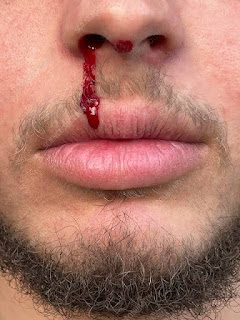Understanding Epistaxis: Causes, Management, and Prevention
Epistaxis, commonly known as a nosebleed, is a frequent and usually benign condition that can affect individuals of all ages. While the majority of nosebleeds are not serious, they can be alarming and uncomfortable. Understanding the causes, effective management strategies, and preventive measures can help mitigate the incidence and impact of epistaxis.
Causes of Epistaxis
Nosebleeds are classified into two main categories: anterior and posterior.
1. Anterior Epistaxis:
Anterior nosebleeds originate from the front part of the nasal septum, specifically Little’s area or Kiesselbach’s plexus. This region is rich in blood vessels and is prone to bleeding due to several factors, including:
- Dry Air: Low humidity can dry out the nasal membranes, leading to cracking and bleeding.
- **Nasal Trauma:** Nose picking, blowing the nose forcefully, or direct injury to the nose.
- **Inflammation and Infection:** Allergic rhinitis, sinusitis, or upper respiratory infections.
- **Medications:** Use of anticoagulants, antiplatelet drugs, and nasal sprays.
- **Foreign Bodies:** Particularly common in children who may insert objects into their nostrils.
- **Chemical Irritants:** Exposure to harsh chemicals, including cleaning agents and industrial fumes.
2. Posterior Epistaxis:
Posterior nosebleeds are less common but often more serious. They originate deeper in the nasal cavity, involving larger blood vessels like the sphenopalatine artery. Causes include:
- Hypertension: Elevated blood pressure can increase the risk of bleeding.
- Blood Disorders: Conditions such as hemophilia or leukemia.
- Atherosclerosis: Hardening of the arteries.
- Nasal and Sinus Surgery: Recent surgical interventions can predispose individuals to bleeding.
- Tumors: Both benign and malignant growths within the nasal cavity.
- Genetic Conditions: Hereditary hemorrhagic telangiectasia (HHT), a genetic disorder causing abnormal blood vessel formation.
Little’s area, also known as Kiesselbach's plexus, is a region located on the anterior part of the nasal septum where several arteries converge. It is a highly vascularized area and is a common site for nosebleeds (epistaxis). This area includes branches from:
- The anterior ethmoidal artery (a branch of the ophthalmic artery).
- The sphenopalatine artery (a branch of the maxillary artery).
- The greater palatine artery (another branch of the maxillary artery).
- The superior labial artery (a branch of the facial artery).
Due to the confluence of these vessels, Little's area is particularly prone to bleeding, especially in dry or irritated conditions, such as those caused by dry air, trauma, or inflammation. Managing nosebleeds from Little’s area typically involves applying direct pressure, using nasal decongestants, or in more severe cases, medical interventions like cauterization or nasal packing.
Management of Epistaxis
Effective management of nosebleeds involves immediate first aid measures and, if necessary, medical intervention.
First Aid Measures:
1. Stay Calm: Anxiety can elevate blood pressure, worsening the bleed.
2. Sit Upright: Lean slightly forward to prevent blood from flowing into the throat.
3. Pinch the Nostrils: Apply firm pressure by pinching the soft part of the nose, holding for about 10-15 minutes.
4. Cold Compress: Apply a cold compress to the bridge of the nose to constrict blood vessels.
5. Avoid Tilting the Head Back: This can cause blood to flow into the throat and potentially lead to choking or vomiting.
Medical Interventions:
- Nasal Packing: Inserting gauze or nasal sponges to apply pressure internally.
- Cauterization: Chemical or electrical cautery to seal bleeding vessels.
- Medications: Topical vasoconstrictors or nasal creams to reduce bleeding.
- Surgical Procedures: In severe cases, arterial ligation or endoscopic surgery may be required.
- Endovascular Embolization: Minimally invasive procedure to block the blood vessels causing the bleeding.
Prevention of Epistaxis
Preventing nosebleeds involves addressing underlying causes and maintaining nasal health:
- Humidify the Air: Use a humidifier in dry environments to keep nasal passages moist.
- Nasal Saline Sprays: Regular use of saline sprays can help keep the nasal mucosa hydrated.
- Avoid Nasal Irritants: Minimize exposure to smoke, strong odors, and allergens.
- Gentle Nasal Hygiene: Avoid aggressive nose blowing or picking.
- Protective Gear: Use appropriate equipment during activities that risk nasal injury.
- Medical Management: Control underlying conditions such as hypertension and use blood-thinning medications cautiously under medical guidance.
- Hydration: Drink plenty of fluids to maintain overall mucous membrane health.
- Avoid Aspirin and NSAIDs: Unless prescribed, as these can thin the blood and increase bleeding risk.
- Regular Check-ups: For individuals with known risk factors, regular monitoring by a healthcare provider can help prevent complications.
When to Seek Medical Attention
While most nosebleeds can be managed at home, certain situations require professional care:
- Persistent Bleeding: If bleeding continues despite first aid measures for more than 20 minutes.
- Frequent Recurrences: Repeated episodes without clear triggers.
- Associated Symptoms: Dizziness, weakness, or significant blood loss.
- Underlying Conditions: Presence of blood disorders or recent surgery.
- Heavy Bleeding: Rapid blood loss that could lead to shock.
- Nosebleed in Children: Particularly if recurrent, as it could indicate an underlying issue.
Conclusion
Epistaxis is a common condition with a variety of causes ranging from environmental factors to medical conditions. While most nosebleeds can be easily managed with simple first aid, understanding when to seek medical intervention is crucial. Preventive measures play a significant role in reducing the occurrence of nosebleeds, thereby improving quality of life and minimizing the need for medical treatments. By maintaining a healthy nasal environment and addressing any underlying health issues, individuals can effectively manage and prevent epistaxis.










Comments